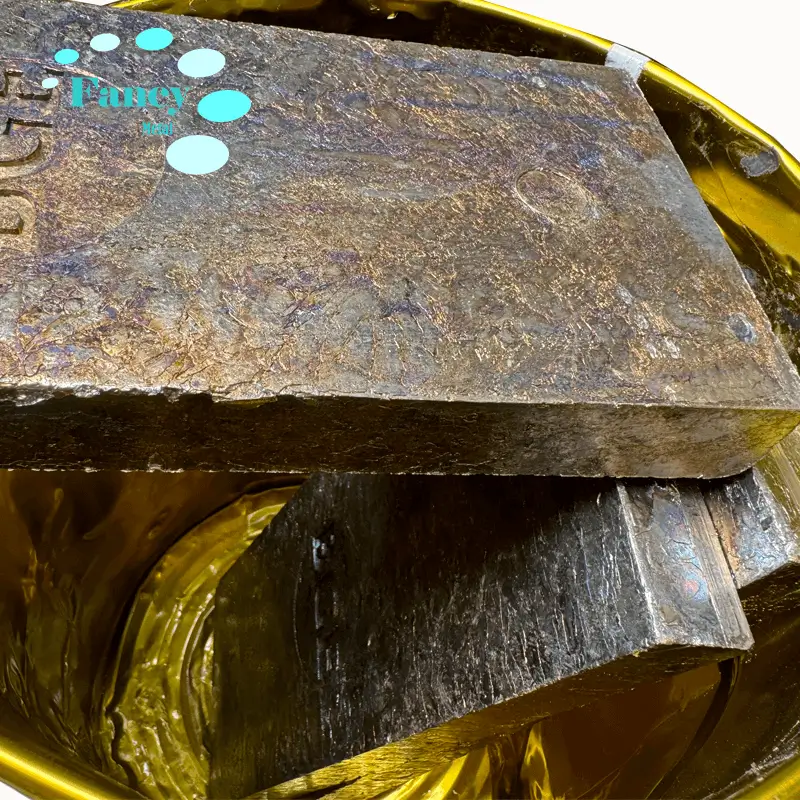Fancymetal offers high purity (customizable) metal products, as well as oxides, product shapes, foils, plates, wires, tubes, rods, powders and a variety of custom shapes.
We also have other bismuth products:
Bismuth
Bismuth Ingot
Bismuth Metal
Bismuth Oxide
Bismuth needle
Bismuth, as a single substance, is a silvery white to pink metal that is brittle and easy to crush. The chemical properties of bismuth are relatively stable. Bismuth exists in nature as free metal and minerals.
Chemical properties:
Bismuth can burn when heated above its melting point, emitting a light blue flame to produce bismuth trioxide. Bismuth can also be combined with sulfur and halogens when it is red hot. Bismuth is insoluble in water and non-oxidizing acids (such as hydrochloric acid). Even concentrated sulfuric acid and concentrated hydrochloric acid only react slightly when heated, but it can be dissolved in aqua regia and concentrated nitric acid. Among them, the +5-valent compound NaBiO3 (sodium bismuthate) is a strong oxidant.
Preparation method:
The treatment of high-grade bismuth concentrate is mostly carried out by pyrometallurgical reverberatory furnace smelting. Bismuth concentrate is mixed with reducing agent coal powder, replacement agent iron filings, group solvent soda ash and other ingredients, and added to the reverberatory furnace for mixed smelting to produce slag, matte and crude bismuth. Crude bismuth is refined to produce refined bismuth.
In hydrochloric acid solution, ferric chloride can oxidize the sulfur element of bismuth sulphite in bismuth ore, so that Bi3+ is transferred into the solution and the sulfur element is converted into elemental sulfur. Adding hydrochloric acid can not only increase the leaching rate of bismuth, but also prevent the hydrolysis of bismuth trichloride in the solution. Bismuth ore is added to the leachate for reduction, so that the residual ferric chloride in the solution is reduced to divalent, and iron powder is added to the leachate for replacement to produce sponge bismuth. The replaced solution is passed through chlorine for oxidation and regeneration.
Applications:
✔ Metallurgical additives
✔ Bismuth-based low melting point fusible alloys
✔ Medical treatment
✔ Application of bismuth in flame retardants
✔ Application of bismuth in chemical industry. For example, bismuth yellow pigment, bismuth salt, bismuth hydroxide and bismuth chloride.
✔ Electronic ceramics. Bismuth germanate crystal is a new type of scintillating crystal used in the manufacture of nuclear radiation detectors, x-ray plane scanners, electro-optics, piezoelectric lasers and other devices; bismuth calcium vanadium (pomegranate ferrite is an important microwave gyromagnetic material and magnetic package material), bismuth oxide-doped zinc oxide varistor, bismuth-containing boundary layer high-frequency ceramic capacitors, tin bismuth permanent magnets, bismuth titanate ceramics and powders, bismuth silicate crystals, bismuth-containing fusible glass and more than 10 other materials have also begun to be used in industry.
✔ Semiconductor
✔ Nuclear industry. For example, high-purity bismuth (99.999% Bi) is used as a heat carrier or coolant in nuclear industrial reactors and used to protect atomic fission device materials.
Advantages:
✔ Strict quality control of raw materials, process control and pre-delivery processes.
✔ Strong technical capability makes it a reliable long-term supplier.
✔ Technical support: 24 hours technical support by email or phone.
History:
It was known in the 15th century and was produced by J.Hellot and C.J.Geoffroy in 1737.
Metallic bismuth was used in ancient Greece and Rome as the base of boxes and chests.
But it was not until 1556 that G. Agricola of Germany proposed the view that antimony and bismuth are two independent metals in his book "On Metals". In 1737, Hellot obtained a small sample when analyzing cobalt ore by fire method, but he did not know what it was.
In 1753, C. Geoffroy and T. Bergman of Britain confirmed that bismuth is a chemical element and named it bismuth. In 1757, Geoffroy of France determined it as a new element after analysis and research.

